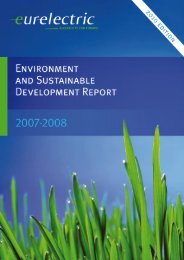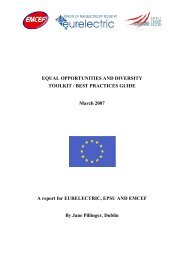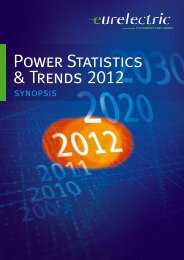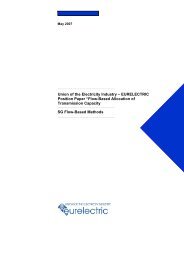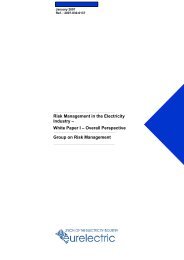Power Statistics - 2010 Edition - Full Report - Eurelectric
Power Statistics - 2010 Edition - Full Report - Eurelectric
Power Statistics - 2010 Edition - Full Report - Eurelectric
You also want an ePaper? Increase the reach of your titles
YUMPU automatically turns print PDFs into web optimized ePapers that Google loves.
Supply 3.4 Comments<br />
146 <strong>Power</strong> <strong>Statistics</strong> – <strong>2010</strong> <strong>Edition</strong> – <strong>Full</strong> <strong>Report</strong><br />
In June 2001 an agreement between the government and the utilities concerning the phasing out of<br />
nuclear energy was made. For each nuclear power station a certain amount for the remaining electricity<br />
production was fixed. Furthermore, the reprocessing of nuclear fuels will be forbidden and the removal<br />
of nuclear waste will be restricted to direct permanent waste disposal. In 2003, the nuclear power plant<br />
in Stade was decomissioned followed by the nuclear power plant in Obrigheim in May 2005. At present,<br />
the federal government proposed a lifetime extension of nuclear power plants for 12 years in average<br />
(plants constructed before 1980: 8 years, others: 14 years).<br />
CHP stations make substantial contributions to the reduction of CO 2 -Emissions because of their high<br />
degree of efficiency. In order to encourage this technology, the law for modernisation and extension of<br />
CHP generation (KWKG) guarantees an additional fee on each kWh produced.<br />
SPAIN (es)<br />
Table 3.1.: in Spain there is not central planning for the expansion of the generation equipment. Therefore,<br />
data of this table should be seen as a possible view of the future made on the basis of the present trends<br />
and the expert’s judgement.<br />
Up to the year 2020, the new generation is based mainly on CCGTs and wind farms.<br />
To define the future capacity needs, it has been considered the technical life of 60 years for nuclear plants,<br />
40 years for the coal plants and 35 years for rest of the thermal plants. It has been taken into account<br />
the constraints set up by National Plant for Emissions Reduction. Referring to new power technologies,<br />
the assumption has been made that the Carbon Capture and Storage will be commercially available in<br />
the 2020 decade.<br />
FINLAND (fi)<br />
The supply side prognosis takes into account Finnish Energy Industries vision for power generation and<br />
district heat production in 2050 and earlier work carried out by Pöyry for Finnish Energy Industries.<br />
Finnish Energy Industries vision Turning challenges into opportunities – a carbon neutral vision for<br />
electricity and district heat for 2050 aims for carbon-neutral production of electricity and district heat<br />
that supports economic growth with a target year of 2050.<br />
The prognosis is based on assumed power plant investments, not on investment plans of individual<br />
companies. Future energy policy, e.g. support schemes and possible licences for nuclear power plants<br />
will have a great influence on investments as well as development of Finnish economy and industry<br />
(forest industry is a major power producer in Finland). Also emissions trading and future price level<br />
of emission allowances may play a big role. For these reasons, the supply side prognosis should be<br />
understood approximately only.<br />
The prognosis is based on the assumption that a sixth nuclear power plant of 1,600 MW will be built and<br />
operational in 2020. A realisation of a sixth power plant requires the Government’s and the Parliament’s<br />
approval. Three applications have been left for the Government.<br />
The usage of wood and other biofuels are assumed to increase considerably in CHP production. Wind<br />
power production is assumed to develop considerably, based on the increasing competitiveness of wind<br />
energy, and feed-in system that is currently being developed by the government.<br />
The main fuel defines the fuel category in the capacity tables. Especially in CHP plants the division<br />
is not always clear, because many CHP plants use peat, industrial wood residues, forest fuel and<br />
waste together. Therefore, the capacity using renewable fuels is classified under the category biomass.<br />
The power plants under the category brown coal are primarily using peat.<br />
Capacity balance in 2008 is based on real peak demand and Fingrid’s (Transmission System Operator)<br />
information about available capacity and technical reserve capacity. Future estimations are based on<br />
current situation and on the assumptions of new generation capacity.<br />
Net transfer capacity to Finland is the capacity, which is in the use of the electricity market. However, it is<br />
not guaranteed that during the Finnish peak demand there will be free production and transfer capacity<br />
in the neighbouring countries.



